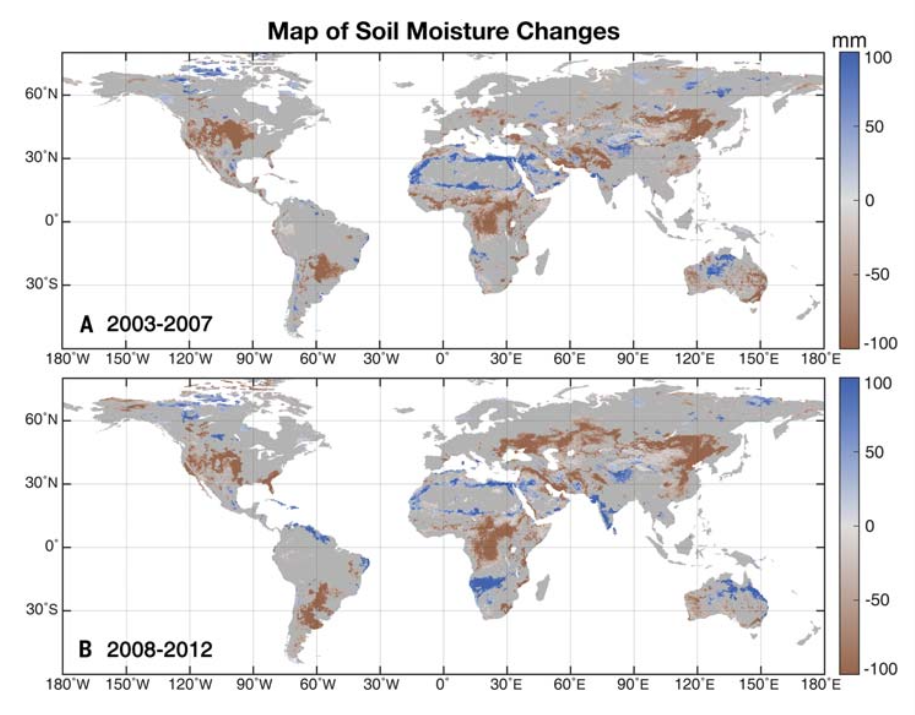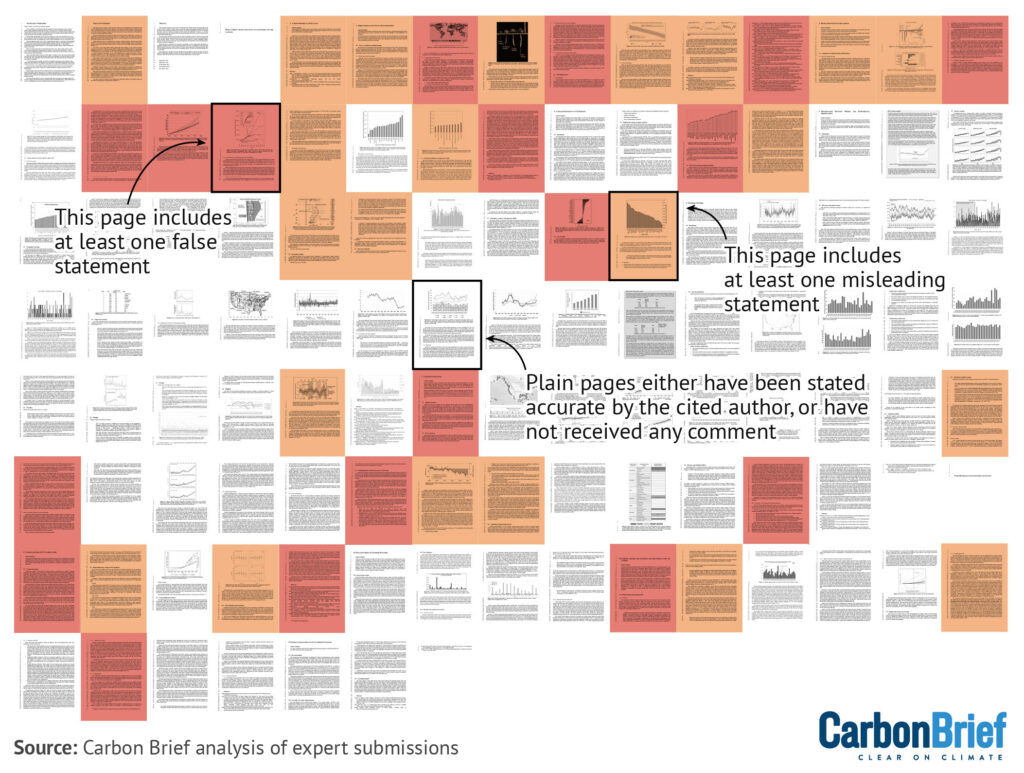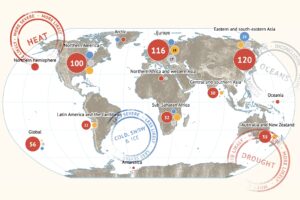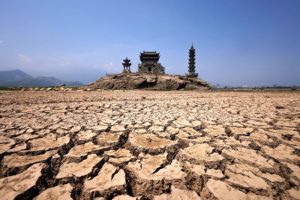A new study warns that global declines in soil moisture in the 21st century could mark a “permanent” shift in the world’s water cycle.
Combining data from satellites, sea level measurements and observations of “polar motion”, the research shows how soil moisture levels have decreased since the year 2000.
The findings, published in Science, suggest the decline is primarily driven by an increasingly thirsty atmosphere as global temperatures rise, as well as shifts in rainfall patterns.
Consequently, the researchers warn the observed changes are likely to be “permanent” if current warming trends continue.
An accompanying perspective article says the study provides “robust evidence” of an “irreversible shift” in terrestrial water sources under climate change.
The drying out of soil “increases the severity and frequency” of major droughts, with consequences for humans, ecosystems and agriculture, explains Dr Benjamin Cook, an interdisciplinary Earth system scientist working at the NASA Goddard Institute for Space Studies and Columbia University, who was not involved in the research.
He tells Carbon Brief:
“Droughts are one of the most impactful, expensive natural hazards out there, because they are typically persistent and long lasting. Everything needs water – ecosystems need water, agriculture needs water. People need water. If you don’t have enough water – you’re in trouble.”
Drying soil
Every year, around 6tn tonnes of water cycles through Earth’s land surface. When rain falls on land it gets held up in soil, wetlands, groundwater, lakes and reservoirs on its journey back to the oceans.
Soil moisture forms a critical part of the Earth’s system, helping to irrigate soil, cycle nutrients and regulate the climate.
The amount of water contained in the soil is sensitive to a range of factors, including changes in rainfall, evaporation, vegetation and climate – as well as human activity, such as intensive agriculture.
The research points to a “gradual decline” in soil moisture levels in the 21st century, kickstarted by a period of “sharp depletion” in the three years over 2000-02.
Specifically, the researchers find the depletion of soil moisture resulted in a total loss of 1,614bn tonnes (gigatonnes, or Gt) of water over 2000-02 and then 1,009Gt between 2002 and 2016.
(For context, ice loss in Greenland resulted in 900Gt of water loss over 2002-06.)
Soil moisture has not recovered as of 2021, according to the research, and is unlikely to pick up under present climate conditions.
Joint-lead author Prof Dongryeol Ryu, professor of hydrology and remote sensing at the University of Melbourne, explains to Carbon Brief:
“We observed a stepwise decline [in soil moisture] twice in the past two decades, interspersed within a continuously declining trend in soil moisture. We haven’t seen this trend earlier, so that is why this is very concerning.”
Ryu explains the decision to analyse changes to soil moisture on a global scale meant the researchers could confirm trends difficult to see in smaller geographic datasets:
“The unique thing we found through analysing these larger-scale measures is that – even if we have seen widely fluctuating ups and downs in precipitation and increasing temperature – the total water contained in the soil, as soil moisture and groundwater, has been declining gradually from around the beginning of this century.“
The maps below illustrate soil moisture changes in 2003-07 and 2008-12 against a 1995-99 baseline, as estimated by the ERA5-Land reanalysis dataset. The areas marked on the map in brown saw a drop in soil moisture and the areas marked in blue an increase in soil moisture.
The top map shows soil moisture depletion across large regions in eastern and central Asia, central Africa and North and South America over 2003-07. The lower map shows that “replenishment” in the years that followed occurred in relatively small parts of South America, India, Australia and North America.

Climate change
Ryu says the researchers “suspect that increasing temperature played an important role” in the decline in terrestrial water storage and soil moisture in the 21st century.
The study points to two factors driving gradual depletion of soil moisture over the last quarter century: fluctuations to rainfall patterns and increasing “evaporative demand”.
Evaporative demand refers to the atmosphere’s “thirst” for water, or how much moisture it can take from the land, vegetation and surface water.
Studies have highlighted how global evaporative demand has been increasing over the last two decades globally, impacting water availability, hurting crops and causing drought.
The new study notes that “increasing evaporative demand driven by a warming climate” suggests a “more consistent and widespread trend toward drying as temperatures rise”.
Ryu says the “very unusual” drop in water moisture observed over 2000-02 could be attributed to low levels of rainfall globally, which coincided with the “period when evaporative demand started increasing”.
Another – less pronounced – period of rapid soil moisture decline seen over 2015-16 can be attributed to droughts triggered by the 2014-16 El Niño event, Ryu notes.
Ryu says the study findings indicate that soil moisture can no longer bounce back from a dry year, as it has in the past:
“It used to be that when precipitation goes up again, we recover water in the soil. But because of this increasing evaporative demand, once we have strong El Niño years – which lead to much less rainfall for a year or two – it seems that we are not recovering the water fully because of increasing evaporative demand. Because of that – even if we have a wet year following dry years – the water in the soil doesn’t seem to recover.”
Cross-validation
Measuring changes in global soil moisture has historically presented a challenge to scientists, given the lack of comprehensive and direct observations of water in soil.
The researchers attempt to reduce this uncertainty by corroborating the ERA5-Land reanalysis dataset from the European Centre for Medium-Range Weather Forecasts (ECMWF) with three geophysical measurement datasets.
ERA5’s land surface modelling system uses meteorological and other input data to estimate water within the upper few metres of the soil.
These figures were compared with data collected by the Gravity Recovery and Climate Experiment (GRACE) mission – a joint satellite mission between NASA and the German Aerospace Center.
Running since 2002, the GRACE mission tracks changes to the Earth’s gravity by collecting data on groundwater depletion, ice sheet loss and sea level rise. These observations have revealed a persistent loss of water from land to the ocean.
The scientists also cross-reference the ERA5 reanalysis data with a century-old dataset that measures fluctuations in the rotation of the Earth as the distribution of mass on the planet changes.
(The redistribution of ice and water, such as melting ice sheets and depleting groundwater, causes the planet to wobble as it spins and its axis to shift slightly. This is known as “polar motion”.)
The third set of measurements the scientists use is global mean sea level height, which is collected by satellites.
To extract soil moisture changes from this set of data, the researchers subtracted other components of sea level rise from the overall total – including Greenland ice melt, Antarctica ice melt, the impact of increasing sea surface temperature (which expands water volume) and the contribution of groundwater.
This process of elimination left researchers with an estimate of the contribution of soil moisture to global sea level rise.
The study notes that both the sea surface height and polar motion observations “support the conclusion that the abrupt change in soil moisture is genuine”.
Ryu says using global average sea level rise and “Earth wobble” to track water redistribution on land is the “main innovation” applied in the paper.
He adds the value of “reverse engineering” the ERA5 dataset is to understand how to enhance land surface modelling in the future:
“By explaining all the contributing factors to this measurement, you can understand the process. And if you understand the process, you can actually predict what’s going to happen in the future if any of these factors change in a certain manner.”
NASA’s Dr Cook says the “corroborating evidence” supplied by the paper offers a “really strong case that there has been a large-scale decline in soil moisture in recent decades”.
However, he says the relatively short reference period of the study means that identifying the cause of the decline is less clear cut:
“Whether [the decline] is permanent or not is much more uncertain…On these timescales, internal natural variability can be really, really strong. Attributing this decline to something specific – either climate change or internal variability – is much much more difficult.”
Sea level rise
A notable finding in the study’s sea level rise analysis is that terrestrial water storage may have been the dominant driver of sea level rise in the early 21st century.
Specifically, the paper notes that the decline in terrestrial water storage over 2000-02 – when soil moisture plummeted – led to global average sea level rise of almost 2mm annually.
The researchers note this rate of sea level rise is “unprecedented” and “significantly higher” than the rate of sea level rise attributed to Greenland ice mass loss, which they note is approximately 0.8mm a year.
Prof Reed Maxwell, a professor at the High Meadows Environmental Institute at Princeton University, who was also not involved in the study, says the researchers’ efforts to compare soil moisture with other global water stores was “novel” and “opens the door to future study of a more holistic global water balance”.
‘Creeping disaster’
The paper notes that land surface and hydrological models require “substantial improvement” to accurately simulate changes in soil moisture in changing climate.
Current models do not factor the impacts of agricultural intensification, nor the ongoing “greening” of semi-arid regions – both of which “may contribute” to a further decline in soil moisture, it states.
Writing in a perspectives article published in Science, Prof Luis Samaniego from the department of computational hydrosystems at the Helmholtz Centre for Environmental Research says that it is “essential” that next-generation models incorporate human-caused influences such as farming, large dams and irrigation systems.
The study posits that the “innovative methods” for estimating changes in global soil moisture presented in the study provide opportunities to “improve the present state of modelling at global and continental scales”.
More broadly, advances in scientific understanding of changes to soil moisture can help improve the world’s preparedness for drought.
Drought is often described as a “creeping disaster” – because by the time it is identified, it is usually already well under way,
Paper author Ryu explains:
“Unlike a flood and heatwaves, drought comes very very slowly – and has prolonged and delayed consequences. We better be prepared earlier than later, because once drought comes you can expect a long period of consequences.”
Dr Shou Wang, associate professor at the Hydroclimate Extremes Lab and the Hong Kong Polytechnic University, who was not involved in the study, says the research findings are “crucial” for advancing understanding of the “potential drivers and dynamics” of “unprecedented hydrological extremes in a warming climate”. He tells Carbon Brief:
“This is breakthrough work that uncovers the drivers of hydrological regime changes, which are leading to unprecedented hydrological extremes such as compound and consecutive drought-flood events.”
The post Global soil moisture in ‘permanent’ decline due to climate change appeared first on Carbon Brief.
https://www.carbonbrief.org/global-soil-moisture-in-permanent-decline-due-to-climate-change/
Greenhouse Gases
DeBriefed 15 August 2025: Raging wildfires; Xi’s priorities; Factchecking the Trump climate report
Welcome to Carbon Brief’s DeBriefed.
An essential guide to the week’s key developments relating to climate change.
This week
Blazing heat hits Europe
FANNING THE FLAMES: Wildfires “fanned by a heatwave and strong winds” caused havoc across southern Europe, Reuters reported. It added: “Fire has affected nearly 440,000 hectares (1,700 square miles) in the eurozone so far in 2025, double the average for the same period of the year since 2006.” Extreme heat is “breaking temperature records across Europe”, the Guardian said, with several countries reporting readings of around 40C.
HUMAN TOLL: At least three people have died in the wildfires erupting across Spain, Turkey and Albania, France24 said, adding that the fires have “displaced thousands in Greece and Albania”. Le Monde reported that a child in Italy “died of heatstroke”, while thousands were evacuated from Spain and firefighters “battled three large wildfires” in Portugal.
UK WILDFIRE RISK: The UK saw temperatures as high as 33.4C this week as England “entered its fourth heatwave”, BBC News said. The high heat is causing “nationally significant” water shortfalls, it added, “hitting farms, damaging wildlife and increasing wildfires”. The Daily Mirror noted that these conditions “could last until mid-autumn”. Scientists warn the UK faces possible “firewaves” due to climate change, BBC News also reported.
Around the world
- GRID PRESSURES: Iraq suffered a “near nationwide blackout” as elevated power demand – due to extreme temperatures of around 50C – triggered a transmission line failure, Bloomberg reported.
- ‘DIRE’ DOWN UNDER: The Australian government is keeping a climate risk assessment that contains “dire” implications for the continent “under wraps”, the Australian Financial Review said.
- EXTREME RAINFALL: Mexico City is “seeing one of its heaviest rainy seasons in years”, the Washington Post said. Downpours in the Japanese island of Kyushu “caused flooding and mudslides”, according to Politico. In Kashmir, flash floods killed 56 and left “scores missing”, the Associated Press said.
- SOUTH-SOUTH COOPERATION: China and Brazil agreed to “ensure the success” of COP30 in a recent phone call, Chinese state news agency Xinhua reported.
- PLASTIC ‘DEADLOCK’: Talks on a plastic pollution treaty have failed again at a summit in Geneva, according to the Guardian, with countries “deadlocked” on whether it should include “curbs on production and toxic chemicals”.
15
The number of times by which the most ethnically-diverse areas in England are more likely to experience extreme heat than its “least diverse” areas, according to new analysis by Carbon Brief.
Latest climate research
- As many as 13 minerals critical for low-carbon energy may face shortages under 2C pathways | Nature Climate Change
- A “scoping review” examined the impact of climate change on poor sexual and reproductive health and rights in sub-Saharan Africa | PLOS One
- A UK university cut the carbon footprint of its weekly canteen menu by 31% “without students noticing” | Nature Food
(For more, see Carbon Brief’s in-depth daily summaries of the top climate news stories on Monday, Tuesday, Wednesday, Thursday and Friday.)
Captured
Factchecking Trump’s climate report

A report commissioned by the US government to justify rolling back climate regulations contains “at least 100 false or misleading statements”, according to a Carbon Brief factcheck involving dozens of leading climate scientists. The report, compiled in two months by five hand-picked researchers, inaccurately claims that “CO2-induced warming might be less damaging economically than commonly believed” and misleadingly states that “excessively aggressive [emissions] mitigation policies could prove more detrimental than beneficial”80
Spotlight
Does Xi Jinping care about climate change?
This week, Carbon Brief unpacks new research on Chinese president Xi Jinping’s policy priorities.
On this day in 2005, Xi Jinping, a local official in eastern China, made an unplanned speech when touring a small village – a rare occurrence in China’s highly-choreographed political culture.
In it, he observed that “lucid waters and lush mountains are mountains of silver and gold” – that is, the environment cannot be sacrificed for the sake of growth.
(The full text of the speech is not available, although Xi discussed the concept in a brief newspaper column – see below – a few days later.)
In a time where most government officials were laser-focused on delivering economic growth, this message was highly unusual.
Forward-thinking on environment
As a local official in the early 2000s, Xi endorsed the concept of “green GDP”, which integrates the value of natural resources and the environment into GDP calculations.
He also penned a regular newspaper column, 22 of which discussed environmental protection – although “climate change” was never mentioned.
This focus carried over to China’s national agenda when Xi became president.
New research from the Asia Society Policy Institute tracked policies in which Xi is reported by state media to have “personally” taken action.
It found that environmental protection is one of six topics in which he is often said to have directly steered policymaking.
Such policies include guidelines to build a “Beautiful China”, the creation of an environmental protection inspection team and the “three-north shelterbelt” afforestation programme.
“It’s important to know what Xi’s priorities are because the top leader wields outsized influence in the Chinese political system,” Neil Thomas, Asia Society Policy Institute fellow and report co-author, told Carbon Brief.
Local policymakers are “more likely” to invest resources in addressing policies they know have Xi’s attention, to increase their chances for promotion, he added.
What about climate and energy?
However, the research noted, climate and energy policies have not been publicised as bearing Xi’s personal touch.
“I think Xi prioritises environmental protection more than climate change because reducing pollution is an issue of social stability,” Thomas said, noting that “smoggy skies and polluted rivers” were more visible and more likely to trigger civil society pushback than gradual temperature increases.
The paper also said topics might not be linked to Xi personally when they are “too technical” or “politically sensitive”.
For example, Xi’s landmark decision for China to achieve carbon neutrality by 2060 is widely reported as having only been made after climate modelling – facilitated by former climate envoy Xie Zhenhua – showed that this goal was achievable.
Prior to this, Xi had never spoken publicly about carbon neutrality.
Prof Alex Wang, a University of California, Los Angeles professor of law not involved in the research, noted that emphasising Xi’s personal attention may signal “top” political priorities, but not necessarily Xi’s “personal interests”.
By not emphasising climate, he said, Xi may be trying to avoid “pushing the system to overprioritise climate to the exclusion of the other priorities”.
There are other ways to know where climate ranks on the policy agenda, Thomas noted:
“Climate watchers should look at what Xi says, what Xi does and what policies Xi authorises in the name of the ‘central committee’. Is Xi talking more about climate? Is Xi establishing institutions and convening meetings that focus on climate? Is climate becoming a more prominent theme in top-level documents?”
Watch, read, listen
TRUMP EFFECT: The Columbia Energy Exchange podcast examined how pressure from US tariffs could affect India’s clean energy transition.
NAMIBIAN ‘DESTRUCTION’: The National Observer investigated the failure to address “human rights abuses and environmental destruction” claims against a Canadian oil company in Namibia.
‘RED AI’: The Network for the Digital Economy and the Environment studied the state of current research on “Red AI”, or the “negative environmental implications of AI”.
Coming up
- 17 August: Bolivian general elections
- 18-29 August: Preparatory talks on the entry into force of the “High Seas Treaty”, New York
- 18-22 August: Y20 Summit, Johannesburg
- 21 August: Advancing the “Africa clean air programme” through Africa-Asia collaboration, Yokohama
Pick of the jobs
- Lancaster Environment Centre, senior research associate: JUST Centre | Salary: £39,355-£45,413. Location: Lancaster, UK
- Environmental Justice Foundation, communications and media officer, Francophone Africa | Salary: XOF600,000-XOF800,000. Location: Dakar, Senegal
- Politico, energy & climate editor | Salary: Unknown. Location: Brussels, Belgium
- EnviroCatalysts, meteorologist | Salary: Unknown. Location: New Delhi, India
DeBriefed is edited by Daisy Dunne. Please send any tips or feedback to debriefed@carbonbrief.org.
This is an online version of Carbon Brief’s weekly DeBriefed email newsletter. Subscribe for free here.
The post DeBriefed 15 August 2025: Raging wildfires; Xi’s priorities; Factchecking the Trump climate report appeared first on Carbon Brief.
DeBriefed 15 August 2025: Raging wildfires; Xi’s priorities; Factchecking the Trump climate report
Greenhouse Gases
Cropped 13 August 2025: Fossil-fuelled bird decline; ‘Deadly’ wildfires; Empty nature fund
We handpick and explain the most important stories at the intersection of climate, land, food and nature over the past fortnight.
This is an online version of Carbon Brief’s fortnightly Cropped email newsletter. Subscribe for free here.
Key developments
‘Deadly’ wildfires
WINE BRAKE: France experienced its “largest wildfire in decades”, which scorched more than 16,000 hectares in the country’s southern Aude region, the Associated Press said. “Gusting winds” fanned the flames, Reuters reported, but local winemakers and mayors also “blam[ed] the loss of vineyards”, which can act as a “natural, moisture-filled brake against wildfires”, for the fire’s rapid spread. It added that thousands of hectares of vineyards were removed in Aude over the past year. Meanwhile, thousands of people were evacuated from “deadly” wildfires in Spain, the Guardian said, with blazes ongoing in other parts of Europe.
MAJOR FIRES: Canada is experiencing its second-worst wildfire season on record, CBC News reported. More than 7.3m hectares burned in 2025, “more than double the 10-year average for this time of year”, the broadcaster said. The past three fire seasons were “among the 10 worst on record”, CBC News added. Dr Mike Flannigan from Thompson Rivers University told the Guardian: “This is our new reality…The warmer it gets, the more fires we see.” Elsewhere, the UK is experiencing a record year for wildfires, with more than 40,000 hectares of land burned so far in 2025, according to Carbon Brief.
-
Sign up to Carbon Brief’s free “Cropped” email newsletter. A fortnightly digest of food, land and nature news and views. Sent to your inbox every other Wednesday.
WESTERN US: The US state of Colorado has recorded one of its largest wildfires in history in recent days, the Guardian said. The fire “charred” more than 43,300 hectares of land and led to the temporary evacuation of 179 inmates from a prison, the newspaper said. In California, a fire broke out “during a heatwave” and burned more than 2,000 hectares before it was contained, the Los Angeles Times reported. BBC News noted: “Wildfires have become more frequent in California, with experts citing climate change as a key factor. Hotter, drier conditions have made fire seasons longer and more destructive.”
FIRE FUNDING: “Worsening fires” in the Brazilian Amazon threaten new rainforest funding proposals due to be announced at the COP30 climate summit later this year, experts told Climate Home News. The new initiatives include the Tropical Forests Forever Facility, which the outlet said “aims to generate a flow of international investment to pay countries annually in proportion to their preserved tropical forests”. The outlet added: “If fires in the Amazon continue to worsen in the years to come, eligibility for funding could be jeopardised, Brazil’s environment ministry acknowledged.”
Farming impacts
OUT OF ORBIT: US president Donald Trump moved to “shut down” two space missions which monitor carbon dioxide and plant health, the Associated Press reported. Ending these NASA missions would “potentially shu[t] off an important source of data for scientists, policymakers and farmers”, the outlet said. Dr David Crisp, a retired NASA scientist, said the missions can detect the “glow” of plant growth, which the outlet noted “helps monitor drought and predict food shortages that can lead to civil unrest and famine”.
FARM EXTREMES: Elsewhere, Reuters said that some farmers are considering “abandoning” a “drought-hit” agricultural area in Hungary as “climate change cuts crop yields and reduces groundwater levels”. Scientists warned that rising temperatures and low rainfall threaten the region’s “agricultural viability”, the newswire added. Meanwhile, the Premium Times in Nigeria said that some farmers are “harvest[ing] crops prematurely” due to flooding fears. A community in the south-eastern state of Imo “has endured recurrent floods, which wash away crops and incomes alike” over the past decade, the newspaper noted.
SECURITY RISKS: Food supply chains in the UK face “escalating threats from climate impacts and the migration they are triggering”, according to a report covered by Business Green. The outlet said that £3bn worth of UK food imports originated from the 20 countries “with the highest numbers of climate-driven displacements” in 2024, based on analysis from the Energy and Climate Intelligence Unit. The analysis highlighted that “climate impacts on food imports pose a threat to UK food security”. Elsewhere, an opinion piece in Dialogue Earth explored how the “role of gender equity in food security remains critically unaddressed”.
Spotlight
Fossil-fuelled bird decline
This week, Carbon Brief covers a new study tracing the impact of fossil-fuelled climate change on tropical birds.
Over the past few years, biologists have recorded sharp declines in bird numbers across tropical rainforests – even in areas untouched by humans – with the cause remaining a mystery.
A new study published this week in Nature Ecology and Evolution could help to shed light on this alarming phenomenon.
The research combined ecological and climate attribution techniques for the first time to trace the fingerprint of fossil-fuelled climate change on declining bird populations.
It found that an increase in heat extremes driven by climate change has caused tropical bird populations to decline by 25-38% in the period 1950-2020, when compared to a world without warming.
In their paper, the authors noted that birds in the tropics could be living close to their “thermal limits”.
Study lead author Dr Maximilian Kotz, a climate scientist at the Barcelona Supercomputing Center in Spain, explained to Carbon Brief:
“High temperature extremes can induce direct mortality in bird populations due to hyperthermia and dehydration. Even when they don’t [kill birds immediately], there’s evidence that this can then affect body condition which, in turn, affects breeding behaviour and success.”
Conservation implications
The findings have “potential ramifications” for commonly proposed conservation strategies, such as increasing the amount of land in the tropics that is protected for nature, the authors said. In their paper, they continued:
“While we do not disagree that these strategies are necessary for abating tropical habitat loss…our research shows there is now an additional urgent need to investigate strategies that can allow for the persistence of tropical species that are vulnerable to heat extremes.”
In some parts of the world, scientists and conservationists are looking into how to protect wildlife from more intense and frequent climate extremes, Kotz said.
He referenced one project in Australia which is working to protect threatened wildlife following periods of extreme heat, drought and bushfires.
Prof Alex Pigot, a biodiversity scientist at University College London (UCL), who was not involved in the research, said the findings reinforced the need to systematically monitor the impact of extreme weather on wildlife. He told Carbon Brief:
“We urgently need to develop early warning systems to be able to anticipate in advance where and when extreme heatwaves and droughts are likely to impact populations – and also rapidly scale up our monitoring of species and ecosystems so that we can reliably detect these effects.”
There is further coverage of this research on Carbon Brief’s website.
News and views
EMPTY CALI FUND: A major voluntary fund for biodiversity remains empty more than five months after its launch, Carbon Brief revealed. The Cali Fund, agreed at the COP16 biodiversity negotiations last year, was set up for companies who rely on nature’s resources to share some of their earnings with the countries where many of these resources originate. Big pharmaceutical companies did not take up on opportunities to commit to contributing to the fund or be involved in its launch in February 2025, emails released to Carbon Brief showed. Just one US biotechnology firm has pledged to contribute to the fund in the future.
LOSING HOPE: Western Australia’s Ningaloo reef – long considered a “hope spot” among the country’s coral reefs for evading major bleaching events – is facing its “worst-ever coral bleaching”, Australia’s ABC News reported. The ocean around Ningaloo has been “abnormally” warm since December, resulting in “unprecedented” bleaching and mortality, a research scientist told the outlet. According to marine ecologist Dr Damian Thomson, “up to 50% of the examined coral was dead in May”, the Sydney Morning Herald said. Thomson told the newspaper: “You realise your children are probably never going to see Ningaloo the way you saw it.”
‘DEVASTATION BILL’: Brazil’s president, Luiz Inácio Lula da Silva, signed a “contentious” environmental bill into law, but “partially vetoed” some of the widely criticised elements, the Financial Times reported. Critics, who dubbed it the “devastation bill”, said it “risked fuelling deforestation and would harm Brazil’s ecological credentials” just months before hosting the COP30 climate summit. The newspaper said: “The leftist leader struck down or altered 63 of 400 provisions in the legislation, which was designed to speed up and modernise environmental licensing for new business and infrastructure developments.” The vetoes need to be approved by congress, “where Lula lacks a majority”, the newspaper noted.
RAINFOREST DRILLING: The EU has advised the Democratic Republic of the Congo (DRC) against allowing oil drilling in a vast stretch of rainforest and peatland that was jointly designated a “green corridor” earlier this year, Climate Home News reported. In May, the DRC announced that it planned to open the conservation area for drilling, the publication said. A spokesperson for the European Commission told Climate Home News that the bloc “fully acknowledges and respects the DRC’s sovereign right to utilise its diverse resources for economic development”, but that it “highlights the fact that green alternatives have facilitated the protection of certain areas”.
NEW PLAN FOR WETLANDS: During the 15th meeting of the Ramsar Convention on Wetlands, held in Zimbabwe from 23 to 31 July, countries agreed on the adoption of a new 10-year strategic plan for conserving and sustainably using the world’s wetlands. Down to Earth reported that 13 resolutions were adopted, including “enhancing monitoring and reporting, capacity building and mobilisation of resources”. During the talks, Zimbabwe’s environment minister announced plans to restore 250,000 hectares of degraded wetlands by 2030 and Saudi Arabia entered the Convention on Wetlands. Panamá will host the next COP on wetlands in July 2028.
MEAT MADNESS: DeSmog covered the details of a 2021 public relations document that revealed how the meat industry is trying to “make beef seem climate-friendly”. The industry “may have enlisted environmental groups to persuade people to ‘feel better’ about eating beef”, the outlet said, based on this document. The strategy was created by a communications agency, MHP Group, and addressed to the Global Roundtable for Sustainable Beef. One of the key messages of the plan was to communicate the “growing momentum in the beef industry to protect and nurture the Earth’s natural resources”. MHP Group did not respond to a request for comment, according to DeSmog.
Watch, read, listen
MAKING WAVES: A livestream of deep-sea “crustaceans, sponges and sea cucumbers” has “captivated” people in Argentina, the New York Times outlined.
BAFFLING BIRDS: The Times explored the backstory to the tens of thousands of “exotic-looking” parakeets found in parks across Britain.
PLANT-BASED POWER: In the Conversation, Prof Paul Behrens outlined how switching to a plant-based diet could help the UK meet its climate and health targets.
MARINE DISCRIMINATION: Nature spoke to a US-based graduate student who co-founded Minorities in Shark Science about her experiences of racism and sexism in the research field.
New science
- Applying biochar – a type of charcoal – to soils each year over a long period of time can have “sustained benefits for crop yield and greenhouse gas mitigation”, according to a Proceedings of the National Academy of Sciences study.
- New research, published in PLOS Climate, found that nearly one-third of highly migratory fish species in the US waters of the Atlantic Ocean have “high” or “very high” vulnerability to climate change, but the majority of species have “some level of resilience and adaptability”.
- A study in Communications Earth & Environment found a “notable greening trend” in China’s wetlands over 2000-23, with an increasing amount of carbon being stored in the plants growing there.
In the diary
- 18-29 August: Second meeting of the preparatory commission for the Agreement on Marine Biological Diversity of Areas beyond National Jurisdiction | New York
- 24-28 August: World Water Week | Online and Stockholm, Sweden
- 26-29 August: Sixth forum of ministers and environment authorities of Asia Pacific | Nadi, Fiji
Cropped is researched and written by Dr Giuliana Viglione, Aruna Chandrasekhar, Daisy Dunne, Orla Dwyer and Yanine Quiroz. Please send tips and feedback to cropped@carbonbrief.org
The post Cropped 13 August 2025: Fossil-fuelled bird decline; ‘Deadly’ wildfires; Empty nature fund appeared first on Carbon Brief.
Cropped 13 August 2025: Fossil-fuelled bird decline; ‘Deadly’ wildfires; Empty nature fund
Greenhouse Gases
Holding the line on climate: EPA
CCL submits a formal comment on EPA’s proposed endangerment finding rollback
By Dana Nuccitelli, CCL Research Manager
On July 29, the EPA proposed to rescind its 2009 endangerment finding that forms the basis of all federal climate pollution regulations.
Without the endangerment finding, the EPA may not be allowed or able to regulate greenhouse gas pollution from sources like power plants or vehicle tailpipes, as they have done for years. News coverage has framed this as a “radical transformation” and a “bid to scrap almost all pollution regulations,” so it has appropriately alarmed many folks in the climate and environment space.
At CCL, we focus our efforts on working with Congress to implement durable climate policies, and so we don’t normally take actions on issues like this that relate to federal agencies or the courts. Other organizations focus their efforts on those branches of the government and are better equipped to spearhead this type of moment, and we appreciate those allies.
But in this case, we did see an opportunity for CCL’s voice — and our focus on Congress — to play a role here. We decided to submit a formal comment on this EPA action for two reasons.
First, this decision could have an immense impact by eliminating every federal regulation of climate pollutants in a worst case scenario. Second, this move relates to our work because the EPA is misinterpreting the text and intent of laws passed by Congress. Our representatives have done their jobs by passing legislation over the past many decades that supports and further codifies the EPA’s mandate to regulate climate pollution. That includes the Clean Air Act, and more recently, the Inflation Reduction Act. We at CCL wanted to support our members of Congress by making these points in a formal comment.
There has been a tremendous public response to this action. In just over one week, the EPA already received over 44,000 public comments on its decision, and the public comment period will remain open for another five weeks, until September 15.
To understand more about the details and potential outcomes of the EPA’s actions, read my article on the subject at Yale Climate Connections, our discussion on CCL Community, and CCL’s formal comment, which represents our entire organization. As our comment concludes,
“In its justifications for rescinding the 2009 endangerment finding, the Reconsideration has misinterpreted the text of the Clean Air Act, Congress’ decadeslong support for the EPA’s mandate to regulate greenhouse gas emissions from motor vehicles and other major sources, and the vast body of peer-reviewed climate science research that documents the increasingly dangerous threats that those emissions pose to Americans’ health and welfare. Because the bases of these justifications are fundamentally flawed, CCL urges the EPA to withdraw its ill-conceived Reconsideration of the 2009 endangerment finding. The EPA has both the authority and the responsibility to act. Americans cannot afford a retreat from science, law, and common sense in the face of a rapidly accelerating climate crisis.”
After the EPA responds to the public comment record and finalizes its decision, this issue will ultimately be decided by the Supreme Court several years from now.
In the meantime, CCL will continue to focus our efforts on areas where we can make the biggest difference in preserving a livable climate. Right now, that involves contacting our members of Congress to urge them to fully fund key climate and energy programs and protect critical work at the National Oceanic and Atmospheric Administration (NOAA), National Aeronautics and Space Administration (NASA), and Department of Energy. We’ve set an ambitious goal of sending 10,000 messages to our members of Congress, so let’s all do what CCL does best and make our voices heard on this critical issue.
This action by the EPA also reminds us that federal regulations are fragile. They tend to change with each new administration coming into the White House. Legislation passed by Congress – especially when done on a bipartisan basis – is much more durable. That’s why CCL’s work, as one of very few organizations engaging in nonpartisan advocacy for long-lasting climate legislation, is so critical.
That’s especially true right now when we’re seeing the Trump administration slam shut every executive branch door to addressing climate change. We need Congress to step up now more than ever to implement durable solutions like funding key climate and energy programs, negotiating a new bipartisan comprehensive permitting reform bill, implementing healthy forest solutions like the Fix Our Forests Act, and advancing conversations about policies to put a price on carbon pollution. Those are the kinds of effective, durable, bipartisan climate solutions that CCL is uniquely poised to help become law and make a real difference in preserving a livable climate.
For other examples of how CCL is using our grassroots power to help ensure that Congress stays effective on climate in this political landscape, see our full “Holding the Line on Climate” blog series.
The post Holding the line on climate: EPA appeared first on Citizens' Climate Lobby.
-
Climate Change2 years ago
Spanish-language misinformation on renewable energy spreads online, report shows
-
Climate Change Videos2 years ago
The toxic gas flares fuelling Nigeria’s climate change – BBC News
-

 Greenhouse Gases1 year ago
Greenhouse Gases1 year ago嘉宾来稿:满足中国增长的用电需求 光伏加储能“比新建煤电更实惠”
-

 Climate Change1 year ago
Climate Change1 year ago嘉宾来稿:满足中国增长的用电需求 光伏加储能“比新建煤电更实惠”
-

 Carbon Footprint1 year ago
Carbon Footprint1 year agoUS SEC’s Climate Disclosure Rules Spur Renewed Interest in Carbon Credits
-
Climate Change2 years ago
Why airlines are perfect targets for anti-greenwashing legal action
-
Climate Change Videos2 years ago
The toxic gas flares fuelling Nigeria’s climate change – BBC News
-
Climate Change2 years ago
Some firms unaware of England’s new single-use plastic ban








